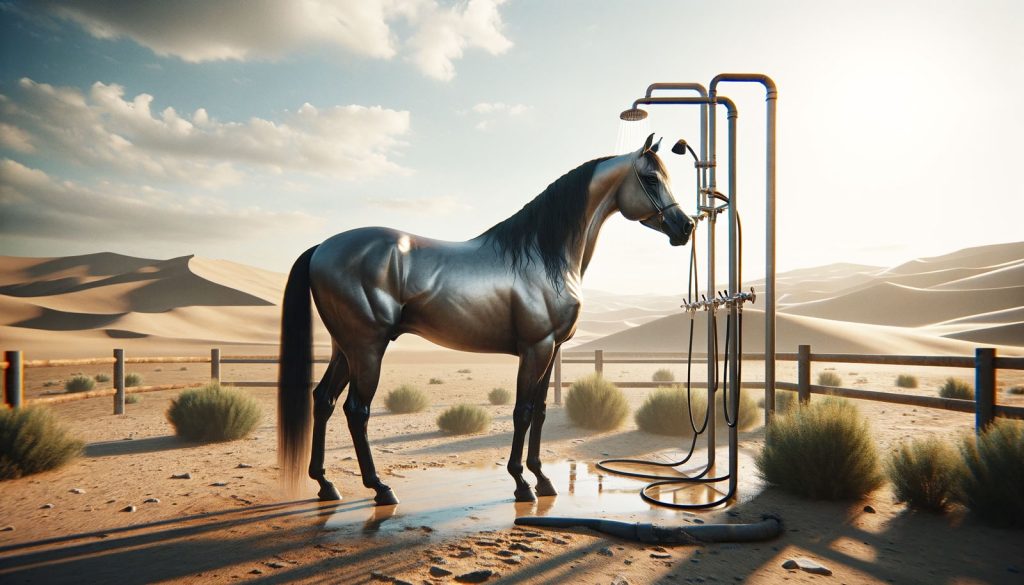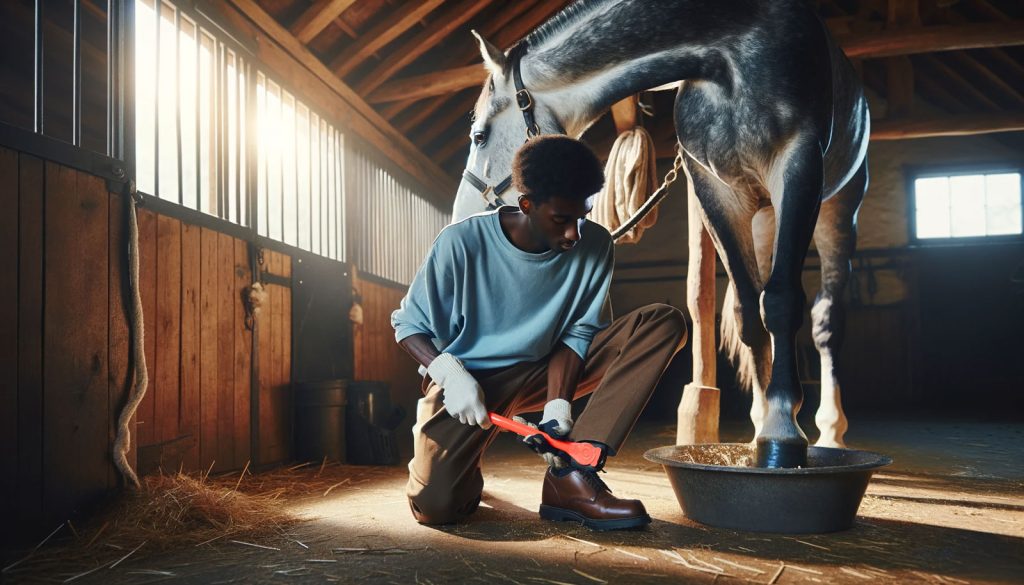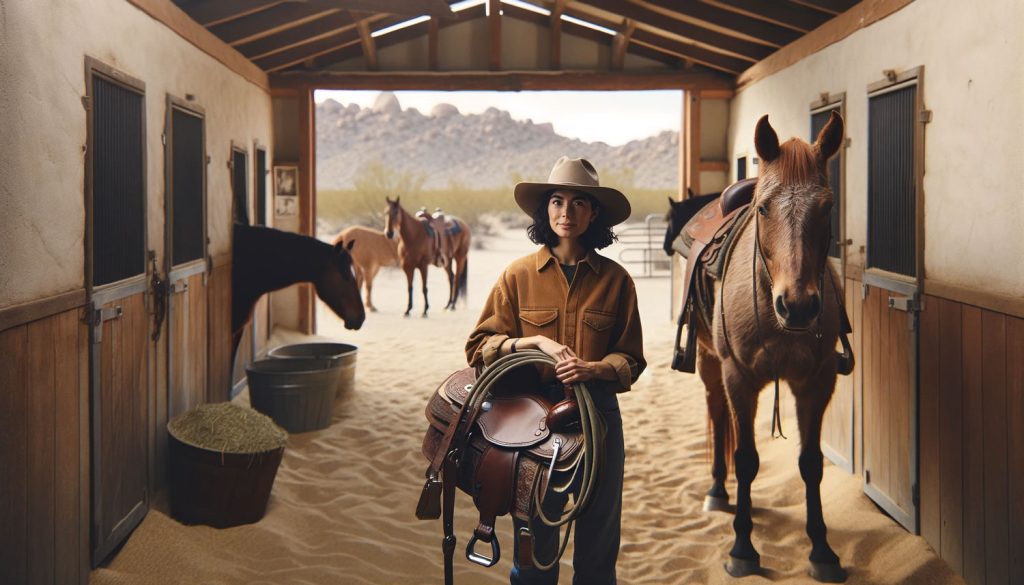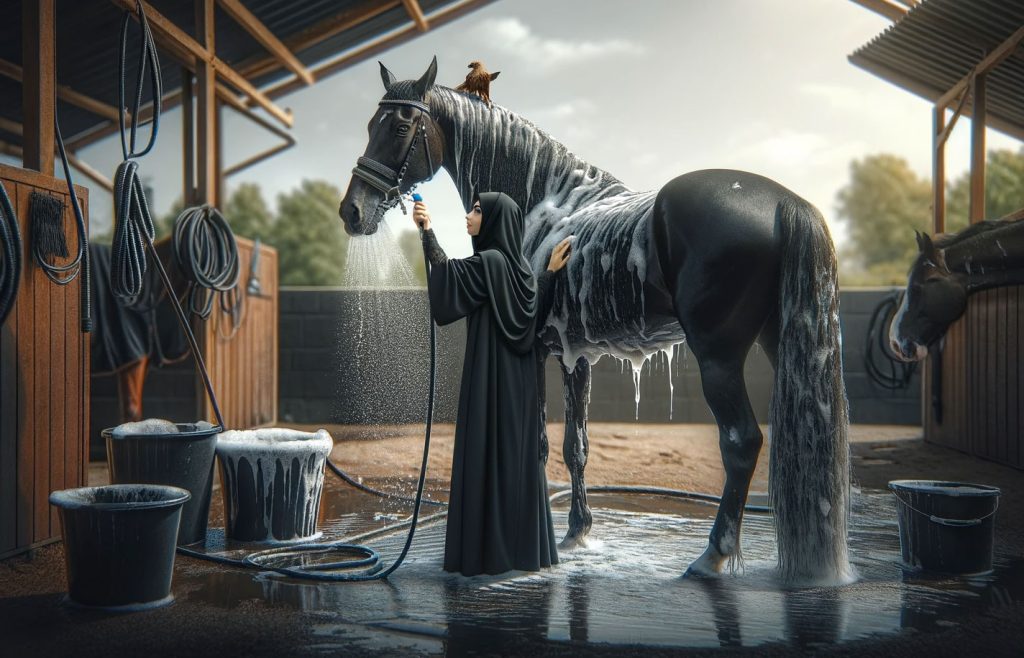How often should one groom a horse? What should be included in a grooming routine before tacking up and after training? Is it okay to wash a horse every day? I will answer all these questions and more in this post about the ideal horse grooming routine.
Recently, I delved into the topic of horse grooming, and I also published another article about essential products and tools for horse grooming. I believe that both horse owners and riders should be fully aware of the benefits of grooming a horse, both on an emotional and physical level, as well as the best practices and tools needed.
As for myself, I’m quite obsessed with grooming my horse, Yazan. I find it not only a relaxing activity for both of us but also a preventive measure against potential skin and hoof problems arising from external conditions. Since I’ve been asked many times questions like, ‘How often do you clean his hooves?’ or ‘Why do you spray that thing on him?’ Well, here we go – you will find all the answers here. So, let’s get to it.
What does a horse grooming routine typically involve?
A typical horse grooming routine includes several steps to ensure the horse’s health, cleanliness, and well-being. Here are some key activities and why they are so important:
- Brushing the coat: Regular brushing stimulates blood circulation, promotes a healthy coat, and distributes natural oils. It helps to remove dirt, loose hair, and dead skin cells, preventing skin issues.
- Cleaning the hooves: Proper hoof care is essential for a horse’s overall health. Cleaning hooves removes debris that could cause discomfort or infection. Regular inspection helps in early detection of issues like thrush or infections such as the White Line Disease, contributing to sound hoof health.
- Mane and tail care: Keeping the mane and tail clean and well-maintained not only enhances the horse’s appearance but also prevents tangling and matting. Regular grooming promotes a healthy hair structure.
- Cleaning face and ears: Cleaning the face and ears helps prevent irritations, especially around the horse’s eye during hot summers. It also fosters trust between the horse and handler, especially for those “head shy” horses.
- Cleaning the sheath (for geldings and stallions): Cleaning the sheath is crucial for maintaining hygiene and preventing discomfort for geldings and stallions. It reduces the risk of infection, promotes reproductive health, and enhances overall well-being.
- Bathing the horse: Bathing helps keep the horse clean, reducing the risk of skin irritations. It is particularly beneficial after strenuous activities. A clean coat allows for better sweat evaporation, promoting a healthier skin and coat.
- Checking for injuries or abnormalities: Regular inspection during grooming allows for the early detection of injuries, cuts, swelling, or abnormalities.
- Additional care: Address specific needs to ensure individualized care. For example applying fly spray (here’s a deep dive on the topic and a list of the best fly repellents on the market), treating skin conditions, or using conditioning products.
A full Grooming routine step-by-step:
Here’s a step-by-step guide to a full horse grooming routine for beginners:
1. Secure the horse:
Before you start grooming, ensure the horse is safely secured in a cross-tie or tied to a solid post. This ensures both the horse’s and your safety during the grooming process.
2. Bathing (Optional):

If the horse is particularly dirty or after strenuous exercise, you may choose to bathe the horse. Use a horse-friendly shampoo and warm water. Rinse thoroughly, ensuring all soap is removed, and allow the horse to dry.
Wait for the horse to fully dry before moving on to the next step. You can use a towel for the legs and a sweat scraper for the body to make the drying process faster.
3. Start by brushing the coat:
Begin by using a curry comb to loosen dirt, mud, and loose hair. Work in circular motions, especially in areas with more hair.
Use a dandy brush to remove the loosened debris and dirt. Brush in the direction of hair growth to avoid discomfort.
Finish with a soft brush for a final polish and to remove any remaining dust.
In this linked article, you will find a list of all the brushes you need to create the perfect grooming kit.
4. Cleaning the hooves and applying hoof oil:

Pick up each hoof and use a hoof pick to remove dirt, rocks, and debris from the frog and sole.
Inspect for any signs of injury, infection, or abnormalities.
Optionally, apply hoof oil to moisturize and condition the hooves. Using a hoof brush or applicator, evenly distribute the oil on the hoof wall and sole. This helps maintain hoof health and prevents cracking.
If this activity is new for you, make sure you are supervised by a more experienced equestrian. There are many risks associated with picking up a horse’s hooves if you don’t know how to do it the right way. Safety comes first!
5. Mane and tail care as part of a horse grooming routine:
Optionally, apply coconut oil or a detangler spray to the mane and tail to prevent breaking the hair while brushing. Wait a couple of minutes for it to work before brushing the hair. Adding a detangler spray or coconut oil can indeed be helpful in maintaining the health of the mane and tail, making the brushing process smoother and more comfortable for the horse.
Use a comb or brush to detangle and remove debris from the mane and tail. Start at the ends and work your way up to avoid causing discomfort (like you would do on your own hair).
You may choose to braid or trim the mane and tail for neatness, but it’s optional.
6. Cleaning face and ears:
Use a soft cloth or sponge to clean the horse’s face, focusing on the eyes, nostrils, and around the mouth. Make sure to use a clean towel, one specifically for the face and ears, and another for the genitals, legs, and body.
Be gentle around sensitive areas like the eyes and ears. A damp sponge can be used to clean the inside of the ears.
7. Cleaning the sheath (for geldings and stallions):
If your horse is a gelding or stallion, attend to the sheath area. Gently clean and remove any dirt or debris using a mild soap or specialized sheath cleaning solution.
Additionally, look for any beans (accumulated smegma) and remove them. If you notice swelling or discomfort, seek the help of a vet.
8. Checking for injuries or abnormalities:
While grooming, inspect the horse’s body for any cuts, swelling, lumps, or other abnormalities. Report any concerns to a veterinarian.
9. Applying additional care products on the coat, mane and tail (Optional):
Depending on the horse’s needs and the environment, apply additional care products such as a fly spray.
10. Offer a treat:
Once the grooming session is complete, reward the horse with a treat. This positive reinforcement helps create a good association with grooming.
Remember, be patient and calm during the grooming process, and observe the horse’s reactions to ensure a positive experience for both you and the horse.
The importance of grooming your horse before tacking up
While I observe that most people, including groomers, underestimate the importance of grooming a horse before tacking up, this is, in fact, particularly crucial for various reasons. When attaching a horse tack, assuming it is well-fitted for the horse to prevent secondary issues, we are fastening items to the horse’s body that inevitably cause friction on the skin during the ride. You have likely noticed the sweat patches on the horse’s back and chest after removing the saddle and breast collars. During summer periods, sweat is also visible behind the ears and at the base of the neck, where the headstall is secured.
All these areas can easily become irritated if sand and old sweat remain on the coat while the horse is being trained or ridden with the tack. This is especially true where the girth lies, particularly behind the horse’s elbows, where a lot of movement occurs while the girth is tightly fastened.
Before riding my horse, I ensure 100% accuracy in brushing on the back (where the saddle and saddle pad go) to avoid residual sand under the coat that may become itchy when the horse sweats. I also make sure that where all the other pieces of tack go (girth, headstall, martingale, etc.), the skin is clean from sand, feed debris, and old sweat. If my horse is wearing polo wraps or tendon boots, I also ensure that his legs are thoughtfully clean to avoid any discomfort during the ride and potential skin irritation that may last a long time.
Checking your tack before riding

Similarly, I ensure my tack is clean before riding or training in the arena. It is especially important to check underneath the saddle and the back of the saddle pad for any debris that might have accumulated in the tack room. Trust me, these straightforward best practices can literally save your life. One of the causes for a horse to buck is an itchy, painful spot under the saddle caused by debris that hasn’t been removed.
How often to bathe a horse?

There is no right answer to this question, as many factors can influence how often you should bathe a horse. Climate conditions, seasonal changes, training frequency and skin conditions are the main factor to consider.
From my personal point of view, I believe a horse should be bathed when brushing alone is not enough to remove dirt from the coat and when at the base of the mane you start to see “white powder” that really needs to be washed off. In addition, I do only consider washing my horse only if the weather allows for him to quickly dry. I absolutely avoid washing in the evening during winter periods for example.
A very common situation after which I often shower my horse is when after riding, I allow him to roll in the arena to overcome the itchy feeling of the sweat. He often looks like a chicken nugget after the roll, so that for me is an absolute yes to a good, refreshing shower.
In the UAE, during summer seasons, daily showers are almost a must if you’re horse is kept outside and you have access to cold water. Horses are often washed during the hottest hours of the day to help them regulate their body temperature. You just have to make sure to remove any excessive water with a sweat scraper that can cause the opposite effect. Residual water on the coat will not evaporate, on the contrary will become quickly warm or hot, giving your horse the sensation of being boiled alive.
Horses produce natural oils on their skin
One other aspect to keep in consideration to evaluate your horse grooming routine and understand how often to bathe a horse is that the horses produce natural oils on their skin. These oils play a crucial role in maintaining healthy skin and coat. The sebaceous glands in a horse’s skin produce sebum, which is an oily substance. The oils contribute to the water-repellent nature of a horse’s coat, helping to shed water during rain or when the horse sweats. The natural oils offer some protection against environmental elements, such as harsh sunlight, wind, and dust. They create a barrier that shields the skin from potential irritants. Ultimately, sebum helps to keep the skin moisturized, preventing it from becoming too dry or flaky. This is essential for maintaining a healthy skin barrier.
While horses have these natural oils, it’s important to note that excessive washing or bathing, especially with harsh soaps, can strip away these oils and lead to dryness and skin issues. Regular grooming practices, such as brushing, can help distribute these oils along the hair shafts, promoting a healthy coat.
In the Gulf regions with dry or arid climates, where moisture loss can be a concern, some horse owners may use equine-friendly coat conditioners or oils to supplement and support the horse’s natural skin oils. However, it’s essential to strike a balance and avoid overuse, as horses generally do well with their natural oil production when kept in a healthy environment.
My weekly grooming Routine with Yazan
If you are curious to learn more about my weekly grooming routine with my horse, Yazan, here’s a video for you to enjoy. I will show step by step which products I use throughout the process.
And what about you? What does your horse grooming routine look like? Which practices and products would you recommend to the equestrian community? Let us know in the comments below.


